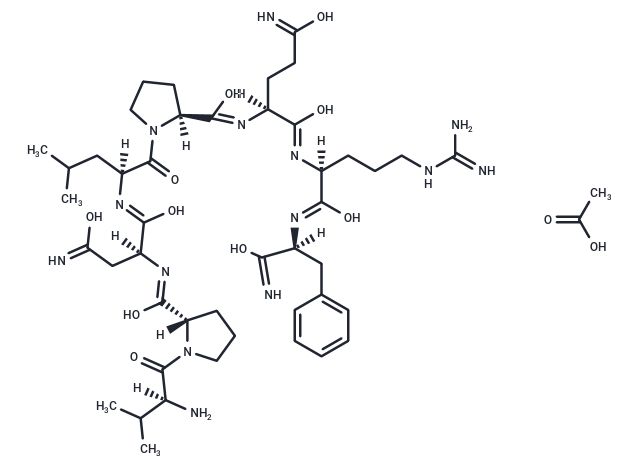Shopping Cart
- Remove All
 Your shopping cart is currently empty
Your shopping cart is currently empty

RFRP-3(human) acetate, a human GnIH peptide homolog, is a potent inhibitor of gonadotropin secretion by inhibiting Ca2+ mobilization. RFRP-3(human) acetate is a NPFF1 receptor agonist, it inhibits forskolin-induced production of cAMP with an IC50 of 0.7 nM.

| Pack Size | Price | Availability | Quantity |
|---|---|---|---|
| 1 mg | $80 | In Stock | |
| 5 mg | $181 | In Stock | |
| 10 mg | $272 | In Stock | |
| 25 mg | $448 | In Stock | |
| 50 mg | $658 | In Stock | |
| 100 mg | $938 | In Stock | |
| 200 mg | $1,280 | In Stock |
| Description | RFRP-3(human) acetate, a human GnIH peptide homolog, is a potent inhibitor of gonadotropin secretion by inhibiting Ca2+ mobilization. RFRP-3(human) acetate is a NPFF1 receptor agonist, it inhibits forskolin-induced production of cAMP with an IC50 of 0.7 n |
| In vitro | RFRP-3(human) acetate efficiently inhibits forskolin-induced production of cAMP with an IC50 of 0.7 nM. Scatchard-plot analysis shows that 125I-labelled hRFRP-3 has a single class of high-affinity binding sites for the membrane fractions of CHO cells expressing rat OT7T022, the Kd value and the Bmax values are 0.19 nM and 1.3 pM, respectively. RFRP-3(human) acetate specifically stimulate cells transfected with a new orphan 7TMR, OT7T022, it binds to OT7T022 as a specific ligand with high affinity (Kd= 0.19 nM)[1]. |
| Molecular Weight | 1029.19 |
| Formula | C47H76N14O12 |
| Smiles | CC(C)C[C@@]([H])(C(N1CCC[C@]1(/C(O)=N/[C@@]([H])(CCC(O)=N)/C(O)=N/[C@@]([H])(CCCNC(N)=N)/C(O)=N/[C@@]([H])(CC2=CC=CC=C2)C(O)=N)[H])=O)/N=C([C@]([H])(CC(O)=N)/N=C([C@@]3(CCCN3C([C@]([H])(C(C)C)N)=O)[H])\O)\O.CC(O)=O |
| Relative Density. | no data available |
| Storage | keep away from moisture | Powder: -20°C for 3 years | In solvent: -80°C for 1 year | Shipping with blue ice. |

Copyright © 2015-2025 TargetMol Chemicals Inc. All Rights Reserved.